Golf Course Photography by Gary Lisbon
Perth isn’t the geographic centre of the golf universe but it sure feels like it once you arrive.
Things in Western Australia are different. And that’s good different, by the way. There’s a discernable edge to our nation’s western third and it filters down to the state’s golf courses. There are locations and layouts the rest of the country simply does not possess and WA magnificently exploits its exceptional natural beauty.
Then there are the state’s golfers. Imagine a representative team drawn solely from WA: Minjee Lee, her brother Min Woo, Jason Scrivener, Curtis Luck and of course the newest sensation, Women’s PGA champion Hannah Green. It’d be a formidable outfit.
A naïve golfer from “over east” might be tempted to ask: what’s been ‘in the water’ in WA golf these past few years? Luck, for one, says he knows the answer. “They’re adding a big portion of hard work into the water. That’s what we’ve got right,” he said in 2016, shortly after being crowned the US Amateur champion hot on the heels of Min Woo Lee’s US Junior Amateur triumph. “From what I know and what I see at events, I’d definitely say we’re hard workers. Not that I’m saying we are necessarily at a disadvantage, but it maybe comes across that we are and that pushes us and makes us strive for more. And that shows in some of the players coming out [of WA] at the moment.”
The knock on Perth has long been how isolated the city is from the rest of the country and the remainder of the world. Or so it might seem. As one high-up figure in Australian golf reminded me, Perth is closer to Europe and South-East Asia than the eastern states. And now London is just a single flight away from the West Australian capital.
During a week-long reacquaintance with all things WA, I asked a handful of club professionals and general managers what it is the state does differently for golfers. Most responded by pointing to two factors: the number and calibre of golf courses plus the agreeable climate. That’s quite the combination. In so many ways, west truly is best.
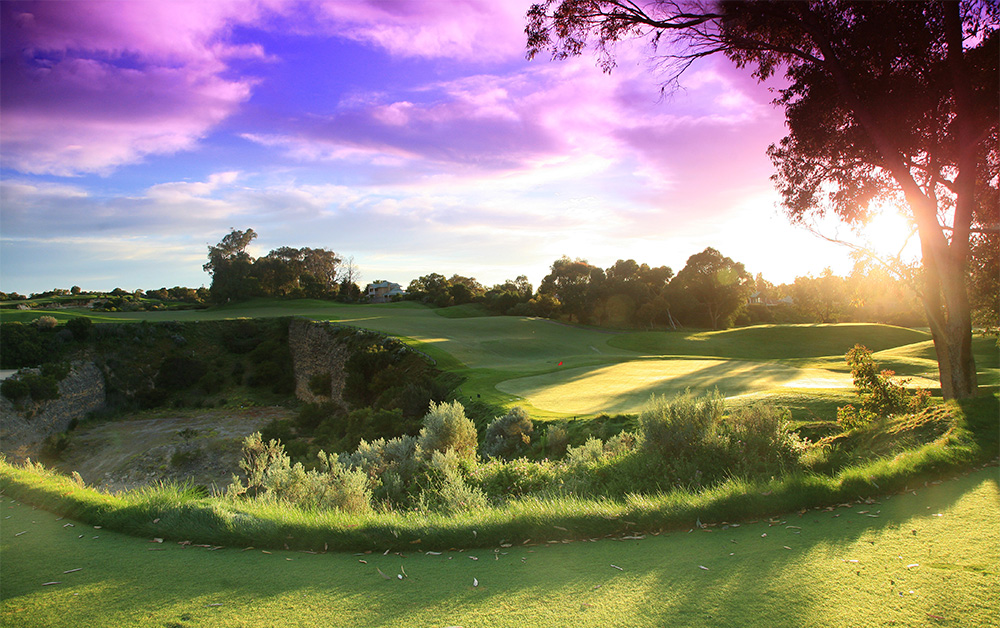
A Golf Adventure
The fulcrum of public-access golf in Perth remains Joondalup Resort. A golf trip to the west that omits an excursion around the ambitious 27-hole complex in the northern suburbs is a missed opportunity. Nowhere else does a setting exist like Joondalup, with its former quarry and moonscape features taking centre stage. But for some golfers the unique surroundings can mask the course’s more conventional architectural features. The greens are huge but undulating – often in extreme ways. Many of the vast putting surfaces play like four or even five greens in one, with voluptuous humps, lumps and bumps separating the various sectors. So while greens in regulation mightn’t be too difficult to achieve, find yourself in the wrong area and problematic putts will result. The bunkers are equally large, many with high walls of sand confronting the golfer trying to escape. Or even literal walls, in the case of the par-5 fourth hole on the Quarry nine. It’s one of the most daunting shots in Australian golf: an uphill fairway bunker shot to a green perched high above and a wall of rock standing nightclub bouncer-like in the road, threatening an ugly and potentially devastating rebuke of a mis-struck shot.
Australian Golf Digest currently ranks Joondalup’s Quarry/Dune combination as the 21st best in the land, and it’s difficult to list any more than 20 designs that are superior. And the course this winter is in summer-like shape with the greens in the kind of condition normally reflecting a peak growth period.
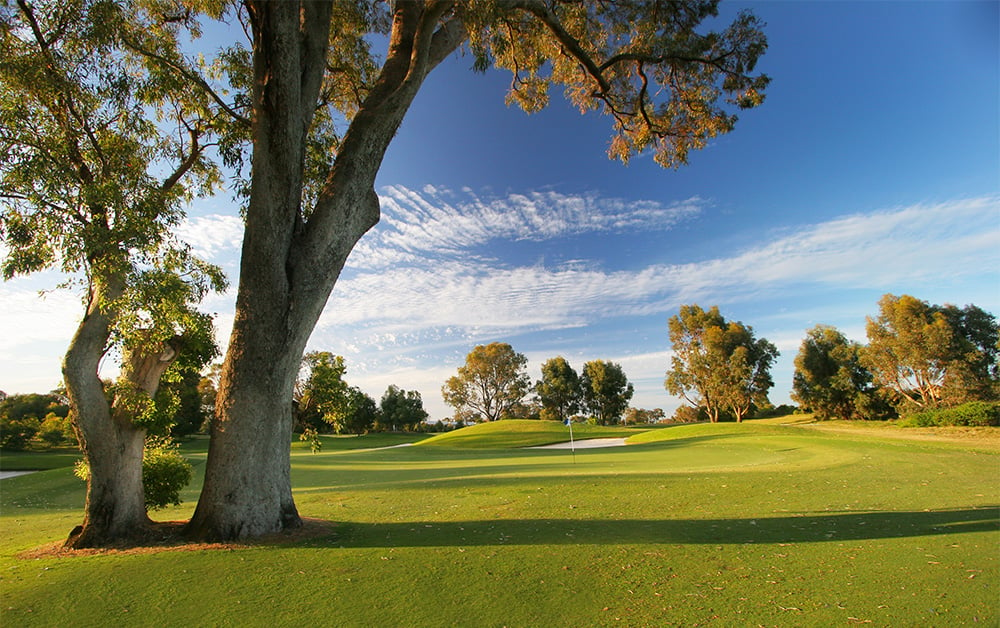
Having the same owners as Joondalup, Meadow Springs Golf & Country Club, an hour’s drive south of the city, is something of a toned down (yet equally appealing) version. Both courses are the work of acclaimed American course architect Robert Trent Jones Jnr, although he displayed a shade more restraint at Meadow Springs. The traits are familiar – large greens, large bunkers that dominate golfers’ eyes and minds and cascading undulations on fairways and greens to challenge high shots and ground-huggers alike.

The two nines at Meadow Springs tour slightly different terrain, with the second side dominated by huge tuart trees for which that half is named. Once upon a time, the nines played the other way around – perhaps to provide a grandstand closing hole at the long, water-laden par 4 that is now the ninth – yet challenges remain whichever way the course plays. The club last year farewelled longtime course superintendent Greg Simmonds, but his replacement, Mike Healy, and his staff have carried on the club’s tradition for excellent conditioning and high standards of turf year-round. Little else has changed at Meadow Springs since it opened in 1993, largely because there was little need to. A couple of new tee complexes are in order for the coming months, partly for variety but also to alleviate any future boundary concerns. It is a reflection on how strong the design is that the only alterations the layout has ever required are due to external influences.
In the same neighbourhood and in the same vein, The Cut Golf Course also has a new course superintendent, Dave Cassidy, who has raised the standard of conditioning on the 14-year-old layout. Some scrub has been cleared and there’s now a little more definition, which adds to the already appealing look of the holes. Interestingly, there’s plenty of definition about what constitutes a good shot on this coastal, James Wilcher design. Many holes feature saddle-style fairways that feed balls lurking near the edges back towards the fairway. Miss these saddles, however, and you’re likely to be re-hitting the shot or taking a penalty drop. The dense vegetation beside most holes is as thick and sinister as Steven Bowditch’s eyebrows.
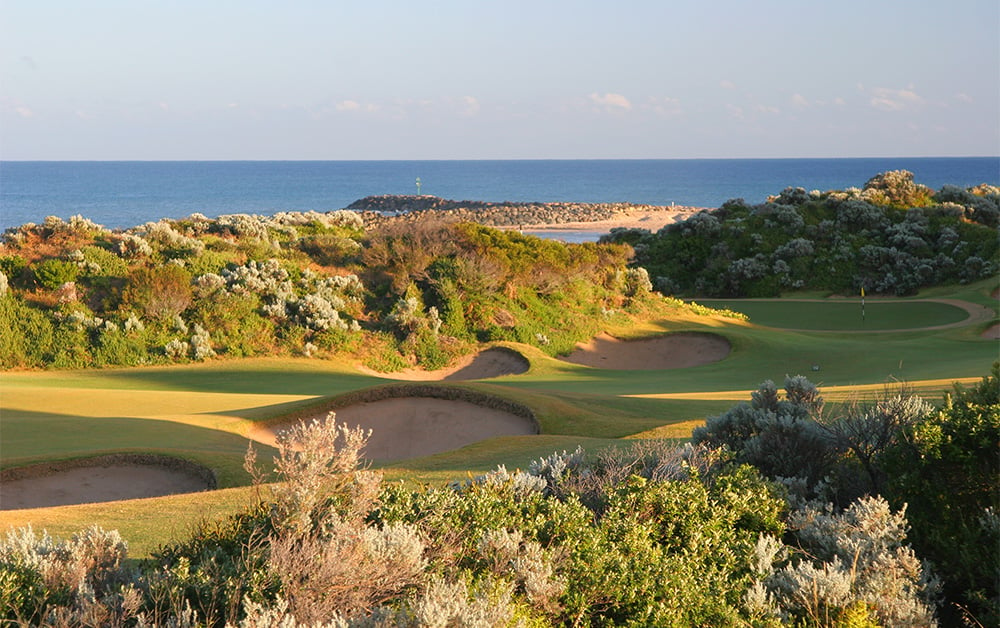
One unmissable aspect of touring The Cut is deciphering the elements. Even seemingly calm days a short distance from the coastline become amplified on its fairways, a zephyr quickly morphing into a stiff breeze, while windy weather inland soon translates into a full-force gale at The Cut. It’s an intrinsic part of playing the course and conquering the wind is to be embraced rather than reviled. However, our advice is to cope with the untimely alarm and book an early tee-time for the best conditions.
Wilcher’s design makes full use of its location hard against the Indian Ocean. Three of the first four holes feature the beach on the left side, while the back nine returns there at several points. Occasionally criticised for a weak section to conclude the front nine (this is the lone portion of the course bordered by a housing estate), holes five to nine are far from bad but lack the majesty and grandeur of the other 13.
Still on the stretch of land aptly known as the Golf Coast, change is in the air for the Links Kennedy Bay. Twenty years after opening, the pot bunker-strewn homage to the great links courses of Britain is preparing for a new look. In March, the Singaporean owners assumed control of the land being used to develop approximately 700 homesites that includes a portion of the existing golf course. It will mean several holes early on the second nine will be lost but replaced by new ones plus – at last – a clubhouse (the club has operated from a demountable building for the past 17 years). The new holes appear likely to sit inland from the current 15th on impressive dunesland featuring more elevation than anywhere on the current layout.
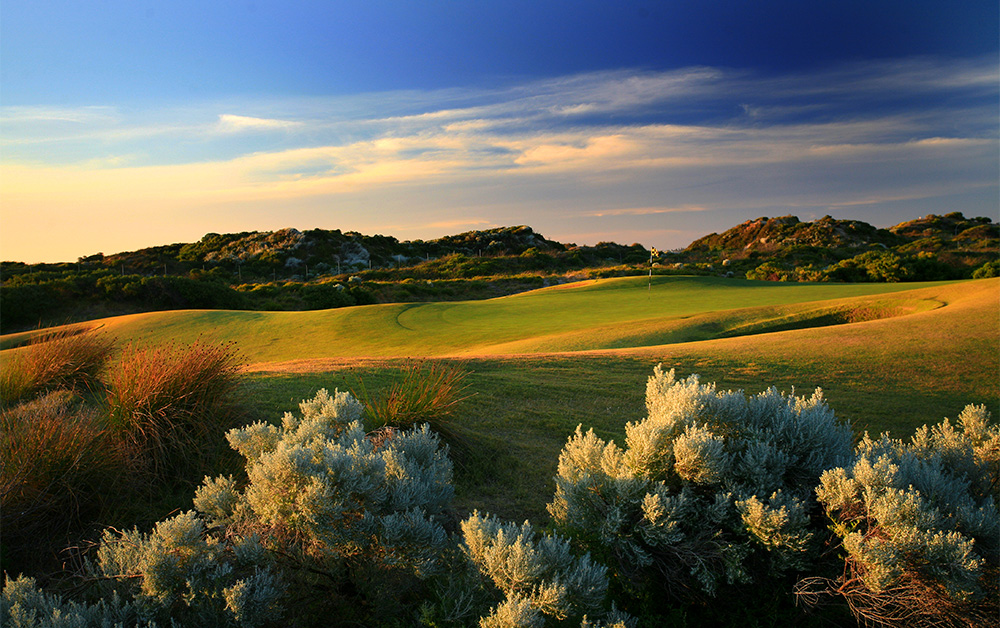
The site for the development was on state government land so an Act of WA Parliament was required for the project to go ahead, but in receiving the green light the owners pledged a commitment to the government to maintain the calibre of the golf course. Indeed, with a little design savvy, Kennedy Bay might wind up being even better than the original Michael Coate, Roger Mackay, Ian Baker-Finch collaboration.
As ever with such projects, a precise timeline is murky but the $5.5 million clubhouse is slated for completion by the end of 2021 and the new golf holes soon afterwards. For now, the logistics around the design of the new holes are a focus, including keeping the course aesthetically the same and moving as little earth as possible. Plus there are practical elements to consider, such as ensuring both nines return to the site of the new clubhouse.
Kennedy Bay is no stranger to change. It was only a few years ago that all play ceased for five months when it appeared complete course closure was imminent. This is a remarkable progression of events from that nadir.
Sleepers No More
Often the measure of a city’s golf courses is the quality of those that don’t make our biennial Top 100 Courses list. Back in Perth, the metropolitan area displays its considerable depth as a golf city via its array of largely unheralded, fully public-access facilities.
One of the great success stories in WA golf is Wembley Golf Course; a more complete facility you will be hard pressed to find. Owned and run by the Town of Cambridge – one of the smallest local government areas in Australia, administering a population of less than 27,000 people – Wembley is a purpose-built public golf facility leading the way in design and functionality to attract more than golfers alone. The complex includes 36 holes, a state-of-the-art 80-bay automated driving range, an exceptional mini-golf course, one of Australia’s largest pro shops plus the state’s only PGA Learning and Performance Centre.
Add to this a stunning, architecturally designed clubhouse, a children’s playground and award-winning catering, and there’s little wonder people are taking notice. In 2018 Wembley was named the Metropolitan Golf Facility of the Year at the Western Australian Gala Golf Industry Awards, in part thanks to an extraordinary 40 percent visitation rate by people who had never played golf before. Wembley has set a benchmark for public golf that is drawing managers from similar facilities to visit and learn from the Wembley story.
Across town, Hartfield Golf Club is noteworthy for being the course where Michael Sim and Rick Kulacz learned the game – two of the leading golfers WA produced prior to the current crop. Hartfield manages to achieve two things that aren’t easy to pull off. Firstly, it’s close to the airport, making it an ideal place for either the first or last round of a golf trip. Secondly, despite that handy location, the site feels like a forest oasis with no clue of the semi-suburban setting apparent anywhere in the 18 holes. The course sits near the Darling Mountains and was carved from dense bushland, with the isolated feel of each fairway still intact today.
“Our course normally trips a lot of people up because of the tightness,” explains longtime head professional Rob Nuttall. “Driving really is at a premium; you really have to hit it on the fairway… As well as trees, some holes also have heavy rough. You’ll normally find your ball, but good luck getting it back on the fairway.”
New general manager Brian Close says members and visitors alike are embracing the challenge of the Hartfield course and all that the club has to offer. “After being a golf club general manager for more than 20 years, I am finding it a pleasure to be given the opportunity to lead this club,” he says. “I welcome every golfer to visit – you won’t be disappointed.”
It’s a sentiment that can be echoed for golf in Perth and the entire south-western corner of the country. The rest of the nation might need to put in a little time to get there but the reward is more than worth the effort.
Whale Of A Time
The golf course at Whaleback, in the suburb of Parkwood south-east of the CBD, isn’t going to win any design awards. It’s a middling golf course that instead attracts attention for two reasons: its curious name and its two-storey driving range that was recently upgraded to include the outstanding TopTracer technology.
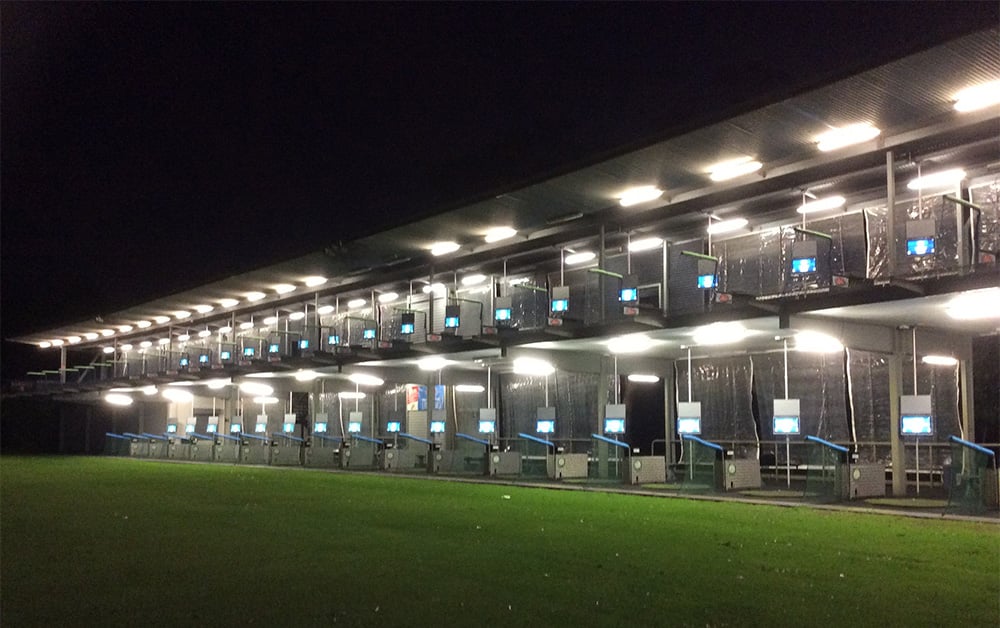 Whaleback Golf Course takes its name from the shape of the space the course sits on. In the early 1970s, a piece of land was allocated as a buffer zone between the proposed Canning Vale industrial area and Lynwood housing estate. When viewed from the air, this parcel of land looked like a big fish and was subsequently called Whaleback Reserve by the City of Canning.
Whaleback Golf Course takes its name from the shape of the space the course sits on. In the early 1970s, a piece of land was allocated as a buffer zone between the proposed Canning Vale industrial area and Lynwood housing estate. When viewed from the air, this parcel of land looked like a big fish and was subsequently called Whaleback Reserve by the City of Canning.
The golf course opened in 1981, but 2019 stands to be the year that truly puts Whaleback on the map. In June, the range became the first in WA – and second in Australia – to install TopTracer, the revolutionary technology that transforms ordinary driving-range sessions into a multi-faceted experience.
With every ball struck, cameras track the shot and provide instant feedback on a screen behind the golfer in each bay – the data even accounting for the 15 percent decrease in carry that range balls typically travel to give accurate distance and flight measurements.
Using a smartphone app, regular TopTracer users can store their personal shot data to monitor progress. The software also allows golfers to ‘play’ various holes and courses from around the world, challenge friends and more.
Whaleback has increased its prices for a bucket of balls – but in doing so also increased the number of balls in a bucket by the same proportions, so TopTracer effectively comes at no extra cost to
golfers, which made it an instant hit.
“Several golfers showed up every day the first week after it was put in,” says Whaleback’s professional Peter Hopkins.
TopTracer means more quality practice time. Golfers no longer simply pound ball after ball into the wide green yonder, instead they stop after each shot, assess the result and adjust if necessary before hitting the next ball. Practising just got a whole lot more interesting.



